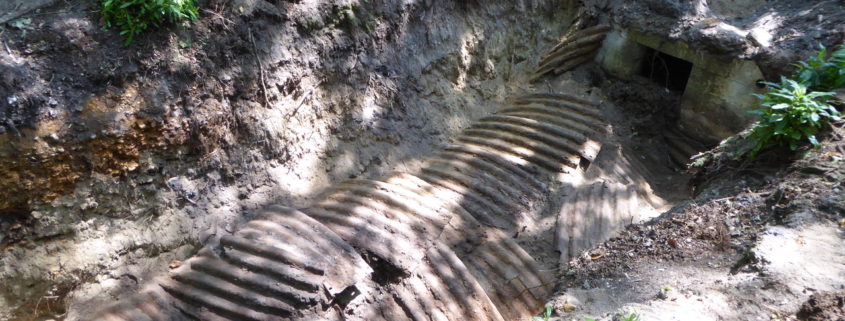Secret Auxiliary Units Bunker excavated at Binnegar Quarry
An archaeological assessment has revealed how Binnegar Quarry near Wareham was the site of an underground hideout for the secret Auxiliary Units, Britain’s wartime resistance in waiting. Andrew Joseph Associates Archaeology Services, working under contract to Raymond Brown, recognised the significance of the site as unusual, on a quarry site that also contained Bronze Age barrows and Battery Bank, a boundary marker and scheduled ancient monument. Experts were called in to assess the site from Historic England, the County Archaeologist and specialist Auxiliary Units research group, Coleshill Auxiliary Research Team (CART).
The Auxiliary Units were set up in 1940 in case of a Nazi invasion. Their role was to hide underground while the first wave of an invasion passed by and then emerge to sabotage supplies, transport and communications to hamper the German forces and allow a counter attack. Made up of six to seven men in a patrol, drawn from local civilians, they were taught demolition and issued large quantities of explosives and weapons. Each patrol had an underground hideout where they could rest and store their supplies. It would be carefully disguised against discovery. The men were told their life expectancy after invasion was just a couple of weeks.
The expert review revealed that the bunker was partially collapsed and heavily damaged. As it was not in a fit state for preservation, it was agreed that it would be fully recorded by archaeological investigation prior to its deconstruction. This was done in stages over 18 months from 2017 and 2018. CART volunteers lead the project with specialist archaeological support from Ian Meadows from Andrew Josephs Associates and the New Forest National Parks Community Archaeology Service. Raymond Brown provided plant to assist the excavation and transport to the remote site and local residents were kept updated throughout by Councillor Barry Quinn who attended regularly to review its progress.
Very few such underground bunkers have been excavated in this way. The dig found a sturdy Nissen hut-like main chamber with an entrance shaft at one end and a short tunnel and escape exit at the other. It revealed that it had been intentionally collapsed in the 1970s, with the centre of the roof removed and the interior filled with sand, however, some elements of its wartime use remained. At the base of the shafts were found remains of the hatch mechanisms including a heavy concrete counter weight. These were used to vertically lift a heavy soil covered hatch that disguised the shaft. The dig revealed an extensive ventilation system, made from over one hundred four inch glazed earthenware pipes brought in from the Midlands. This relied on warm air rising through pipes set in the roof which drew in fresh air through other pipes running to the bottom of the bunker. In the base of the tunnel were found numerous inert trap switches. These had been deliberately deactivated by whoever had discarded them, the empty boxes they came in being found nearby. Other similar devices had been found as part of an extensive metal detector survey of the surrounding area indicating that the men had been training nearby. This survey also found a metal first aid splint and a .50 calibre bullet, evidence of the US Army who were briefly based in nearby Binnegar Hall prior to D Day. Other finds included discarded tin cans from a meal eaten by the men who built the bunker, found in backfill outside the bunker walls.
A full report will be lodged with the County Archaeologist in due course and it is hoped to stage an exhibition of the findings in the local area next year. Raymond Brown have donated the finds to CART to be exhibited as part of their public displays explaining the history of Auxiliary Units. It is planned to erect a pair of memorial benches constructed from blocks salvaged from the bunker, to remember the men who received no recognition at the end of the war, due to the secrecy of the organisation.



